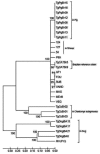Isolation and Genotyping of Toxoplasma gondii in Brazilian Dogs
- PMID: 28719948
- PMCID: PMC5523891
- DOI: 10.3347/kjp.2017.55.3.239
Isolation and Genotyping of Toxoplasma gondii in Brazilian Dogs
Abstract
Strains of Toxoplasma gondii in Brazil are highly genetically diverse compared to strains from North America and Europe. Dogs are epidemiologically important because they act as sentinels for T. gondii infections in humans and are good indicators of environmental contamination. The aim of this study was to isolate and genetically characterize T. gondii strains from tissues of naturally infected Brazilian dogs. For this study, 21 blood samples were collected from dogs at the Zoonosis Control Centers of Ilhéus and Itabuna cities, Bahia, Brazil. The sera were examined for T. gondii antibodies using the indirect hemagglutination test. Brains and hearts of seropositive dogs were bioassayed in mice to isolate and characterize T. gondii parasites by PCR-RFLP using 10 genetic markers (SAG1, newSAG2, SAG3, BTUB, c22-8, c29-2, GRA6, PK1, APICO, and L358). However, T. gondii was isolated from only 4 (57.1%) dogs, designated TgDgBr6, 13, 17, and 21. All strains were virulent, causing clinical changes (rough hair coat, lethargy, and abdominal distention) and the death of all mice within 8-20 days after inoculation. Genetic analysis of these 4 T. gondii isolates revealed 4 distinct genotypes with different clonal lineage combinations (types I, II, and III) and 2 atypical alleles. Using PCR-RFLP with several markers, this study contributes to evaluations of the genetic diversity of strains circulating in Brazil.
Keywords: Brazil; Toxoplasma gondii; dog; genotype; toxoplasmosis.
Conflict of interest statement
We have no conflict of interest related to this work.
Figures



References
-
- Dubey JP, Beattie CP. Toxoplasmosis of Animals and Man. Florida, USA: CRC; 1988. pp. 1–220.
-
- Dubey JP, Zarnke R, Thomas NJ, Wong SK, Van Bonn W, Briggs M, Davis JW, Ewing R, Mense M, Kwok OC, Romand S, Thulliez P. Toxoplasma gondii, Neospora caninum, Sarcocystis neurona, and Sarcocystis canis-like infections in marine mammals. Vet Parasitol. 2003;116:275–296. - PubMed
-
- Ribeiro LA, Santos LK, Brito PA, Jr, Maciel BM, Da Silva AV, Albuquerque GR. Detection of Toxoplasma gondii DNA in Brazilian oysters (Crassostrea rhizophorae) Genet Mol Res. 2015;14:4658–4665. - PubMed
-
- Dubey JP, Lago EG, Gennari SM, Su C, Jones JL. Toxoplasmosis in humans and animals in Brazil: high prevalence, high burden of disease and epidemiology. Parasitology. 2012;139:1375–1424. - PubMed
-
- Dubey JP. Toxoplasmosis-a waterborne zoonosis. Vet Parasitol. 2004;126:57–72. - PubMed
MeSH terms
Substances
LinkOut - more resources
Full Text Sources
Other Literature Sources

